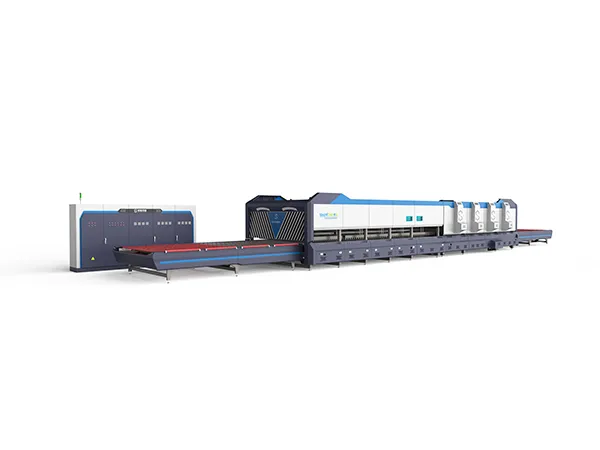Installing a glass tempering furnace for building curtain walls requires detailed planning, appropriate machinery, and adherence to safety standards. Below is a general guide for the specifications and requirements necessary for a proper installation:
1. Site Requirements:
Space: Ensure that the installation area is large enough to accommodate the glass tempering furnace and its related equipment. The space should allow easy movement for loading/unloading glass, as well as routine maintenance activities.
Flooring: The floor should be leveled and strong enough to bear the load of the furnace and the processed glass. Reinforced concrete floors are commonly used to support the furnace weight.
Ventilation: The area must be well-ventilated to disperse heat efficiently. Proper ventilation also helps in maintaining an optimal working environment and preventing overheating of equipment.
Power Supply: Ensure that the site has a suitable electrical power supply to meet the furnace’s requirements. The furnace typically requires high voltage (e.g., 380-480V) and high current capacity.
Water Supply: Some furnaces have water cooling systems, so an adequate water supply must be in place. Make sure there are connections for water inlets and outlets.

2. Foundation Preparation:
Foundation Design: The foundation of the furnace must be designed based on the manufacturer’s specifications. It should include the necessary channels for power, gas, and water supply lines.
Leveling: The foundation should be perfectly leveled to prevent any misalignment of the furnace. Uneven surfaces could cause issues in the glass processing operation and damage the equipment.
Vibration Dampening: Furnaces must be isolated from vibrations, which could affect the tempering process. Special vibration dampening pads or mounts are often used beneath the furnace.
3. Equipment Installation:
Furnace Positioning: Position the furnace so that there is easy access to both the loading and unloading zones. The furnace should be set up in an area that allows for smooth transportation of glass in and out.
Conveyor System: If the furnace has a conveyor system for loading/unloading glass, ensure the system is properly aligned and level. Incorrect alignment could lead to faulty operation or glass breakage.

Heater Installation: Install the furnace’s heating elements according to the manufacturer’s guidelines. This could involve setting up electric heating rods or gas burners, depending on the type of furnace.
Control System: The furnace control system should be installed in a convenient location, allowing operators to monitor and adjust the temperature, time cycles, and other variables in the tempering process.
4. Utility Connections:
Electrical Wiring: Ensure that the wiring and electrical connections meet the furnace's specifications, including voltage, amperage, and power phases. Proper grounding is essential for safety.
Water and Gas: If applicable, connect the water cooling system and any gas lines for gas-fired furnaces. All connections should be secure, and leaks must be avoided.
Compressed Air: Some glass tempering furnaces require compressed air to cool the glass. If so, a suitable compressed air system must be installed, and the piping should be checked for leaks.
5. Safety Features:
Fire Safety: Since the furnace operates at high temperatures, proper fire safety measures should be in place. Fire extinguishers, alarms, and emergency shutoff systems should be installed near the furnace.
Thermal Insulation: The furnace should be equipped with appropriate thermal insulation to retain heat inside the chamber and prevent heat dissipation to the surroundings.
Safety Barriers: Install barriers around the furnace to prevent unauthorized personnel from accessing the high-temperature areas. Warning signs should also be posted.
6. Calibration and Testing:
Temperature Calibration: Once the furnace is installed, its temperature control system should be calibrated to ensure accurate heating. The uniformity of temperature inside the furnace is critical for the quality of tempered glass.
Operational Testing: Conduct a dry run (without glass) to verify that the furnace operates as intended. Check for even heat distribution, proper conveyor functioning, and uniform airflow in cooling sections.
Glass Testing: Test the furnace with a sample of glass to ensure it is being tempered according to the required specifications for curtain walls. Verify that the tempered glass meets strength and safety standards.

7. Maintenance and Support:
Access for Maintenance: Ensure that there is enough space around the furnace for regular maintenance and emergency repairs. Plan the installation so that key components like heaters, fans, and control systems can be easily accessed.
Spare Parts: Keep a stock of critical spare parts such as heating elements, conveyor belts, and glass rollers, to minimize downtime during repairs.
8. Compliance with Standards:
Building Codes: The installation must comply with local building codes and safety regulations. Ensure the furnace adheres to industry standards like CE, ISO, or other relevant certifications for quality and safety.
Glass Tempering Standards: Ensure that the furnace can produce tempered glass that meets international standards such as ASTM C1048 (Standard Specification for Heat-Treated Flat Glass) or equivalent standards in your region.
By following these specifications and ensuring proper installation procedures, the glass tempering furnace can efficiently produce high-quality tempered glass for building curtain walls.










